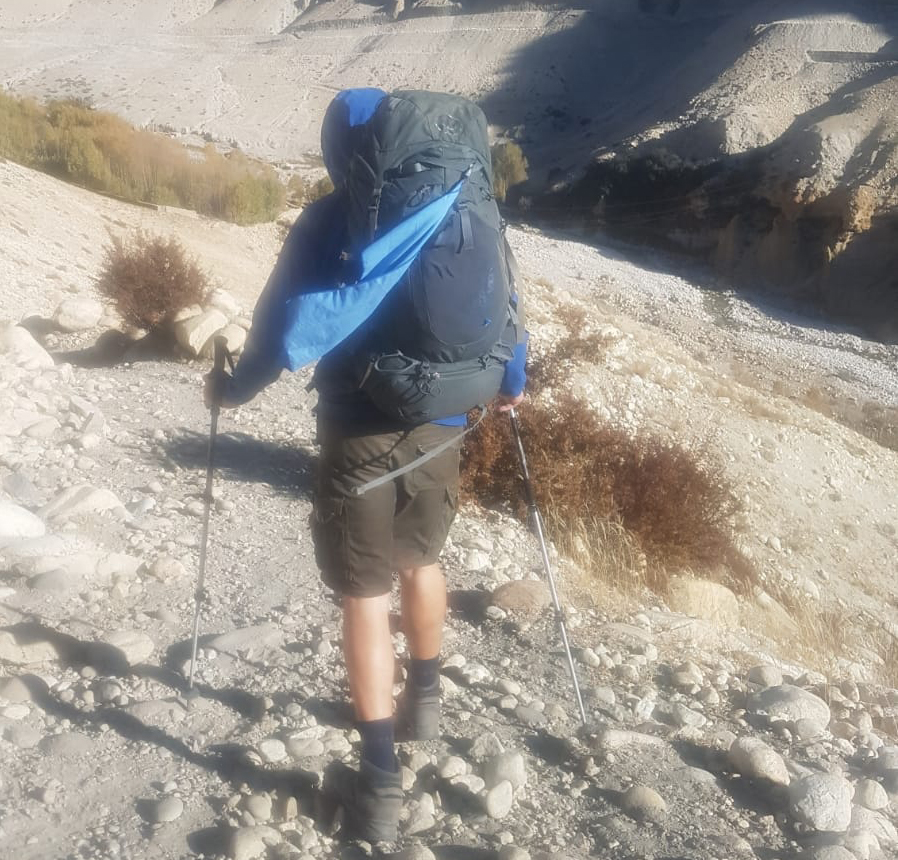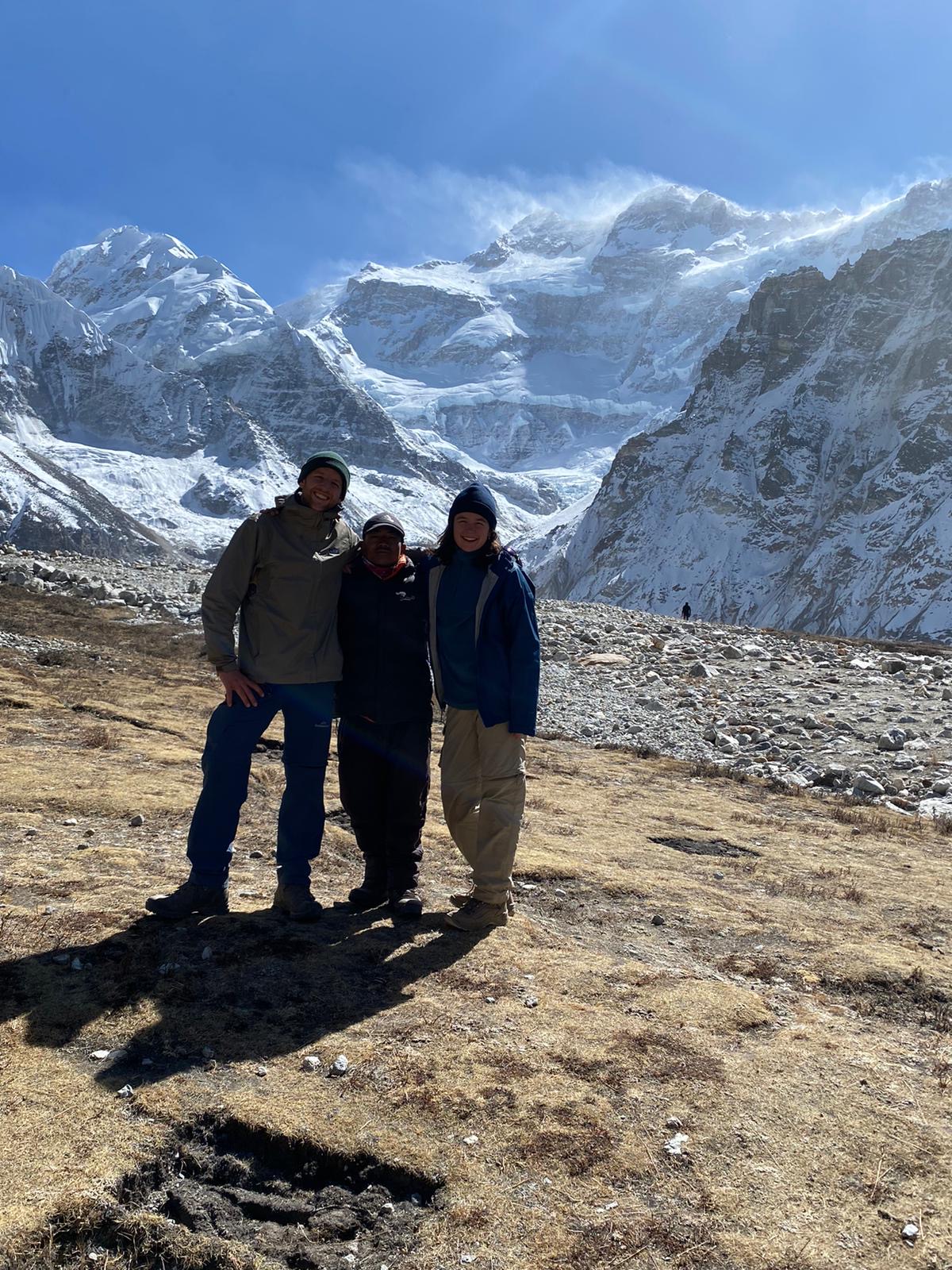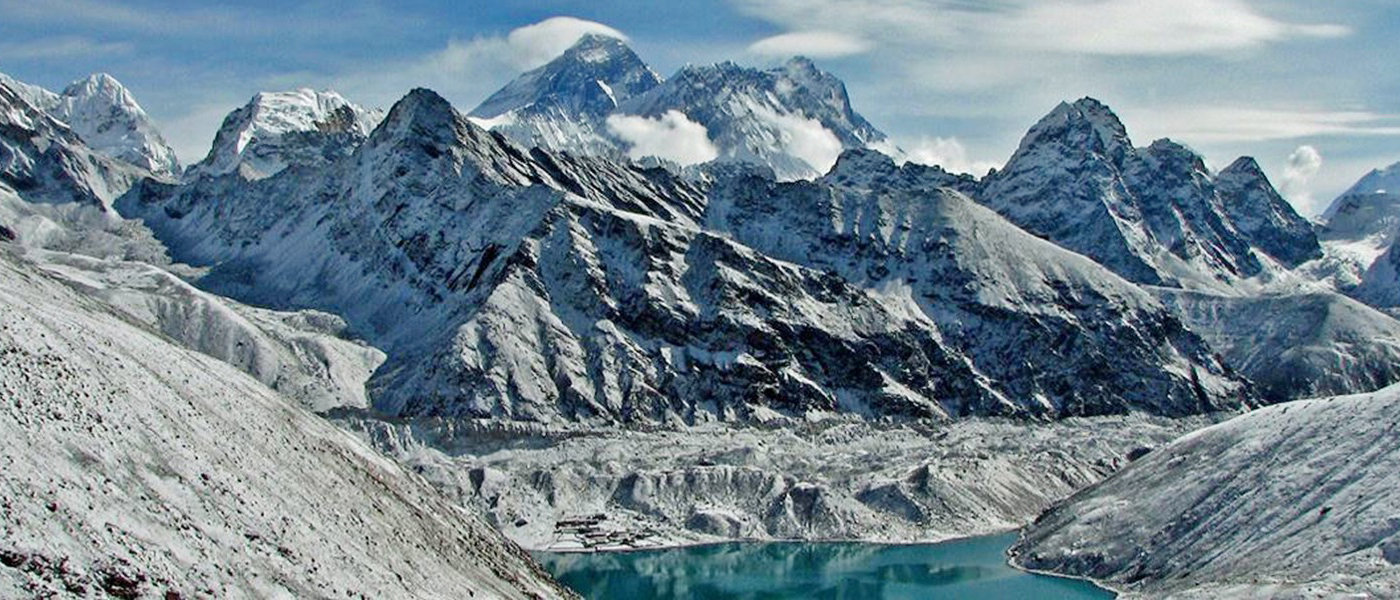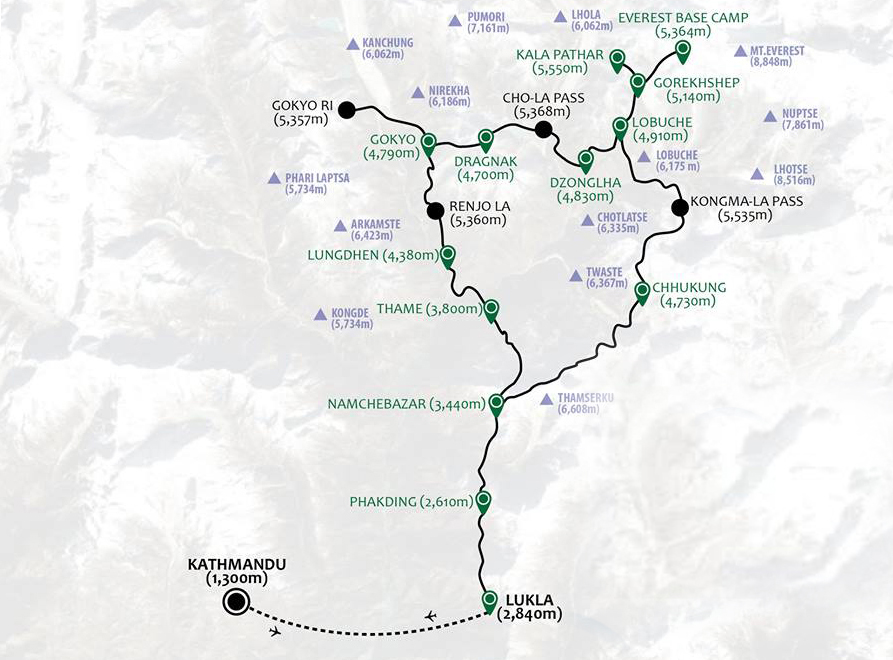Everest Three Pass Trek
The Everest Three Pass trek takes you through three high mountain passes in the area which is a challenging and adventurous trek in the Everest region of Nepal. The trek is known for its spectacular mountain views, unique landscapes, and diverse culture. The three are the Kongma La Pass, Cho La Pass, and Renjo La Pass. Along the way, you will also get to explore popular landmarks of the region, including Everest Base Camp, Kala Patthar, Gokyo Lake, and the Nangpa La Valley. It requires a high level of physical fitness and endurance and the treks are typically 19 days trek.
The trek is recommended for experienced trekkers who have prior experience with high-altitude trekking and who are comfortable with challenging terrain. The best time to go on the Everest Three Pass trek is from March to May and from September and November when the weather is dry and stable, and the views are at their best. It is essential to have a knowledgeable and experienced guide to ensure your safety and make the most out of your trekking experience. From this trekking, we get a chance to have a mesmerizing view of the mountain including Mt Everest, Lhotse, Cho Oyu, and many other beautiful peaks of the wonderful land.
Trip Highlight
- Once-a-lifetime adventure at Khumbu region
- Offer a unique opportunity to explore the beauty of the high Himalayas of Nepal
- Cross three high passes including Kongma La Pass, Cho La Pass, and Renjo La Pass
- Witness a stunning view of the mountain including Mt Everest, Lhotse, Nuptse, Makalu, and Cho Oyu
- Trek into the Sagarmatha National Park
- Experience the thrill of high-altitude trekking
How hard is the Everest Three Pass trek?
The Three Pass trek is a challenging and strenuous trek that requires a good level of fitness and endurance. The trek involves crossing three high mountain passes above 5000 meters from sea level. The trek involves long days of hiking at altitude, often over rocky terrain and steep ascents and descents. The difficulty level of the trek varies depending on a number of factors, including the weather, the pace of the trekker, and the level of acclimatization. It is recommended those trekkers have some prior experience of high altitude trekking and are in good physical condition. However, it is a challenging and rewarding adventure for those who are up for the physical and mental challenging. It is important to take the necessary precautions and be well-prepared for the trek to ensure a safe and enjoyable experience.
Is it possible without a guide and porter on the Everest Three Pass treks?
It is technically possible to do the Three Pass Trek in Nepal without a guide and porter, but it is recommended for most people. The Three Pass Trek is a challenging and remote trek, and having a guide and porter can make the experience safer, more enjoyable, and less stressful.
A guide can help you navigate the trail and ensure that you are on the right path, especially in areas where the route is not well-marked. They can also help you manage your pace and adjust your itinerary to account for altitude sickness or another factor. Additionally, a guide can provide valuable insight into the local culture and costumes, making the trek more enriching.
A porter can carry some of the weight of your gear, food, and other supplies, which can make the trek less physically demanding and allow you to enjoy the scenery and the experience more fully. This can also help to prevent injury or exhaustion, which can be a real risk on a long and challenging trek like the Three Pass Trek.
While it is possible to do the Everest Three Pass Trek without a guide and porter, it is important to be well-prepared and have a good understanding of the route, the terrain, and the potential risks involved. You should also be physically fit and have experienced trekking at high altitudes.
How far is the trek to 3 passes?
The Everest Three Pass trek is a popular multi-day trek in the Everest region of Nepal that crosses three high mountain passes including Renjo La Pass, Cho La Pass, and Kongma La Pass. The total distance of the trek can vary depending on the exact route taken and the starting and ending points, but it is typically around 160 to 170 kilometers in total and takes about 18 to 20 days to complete. However, the distance and duration of the trek can also be affected by factors such as weather conditions, altitude sickness, and individual trekker fitness levels.
How long does the Everest Three Pass trek?
The trek takes around 19 to 22 days to complete, depending on the itinerary and the pace of the trekker. This trek takes you through the three high passes in the Everest region of Nepal, namely the Renjo La Pass, Cho La Pass, and Kongma La Pass, as well as other beautiful destinations such as Gokyo Valley, Everest Base Camp, and Kala Patthar. The trekker needs to be well-prepared physically and mentally, and also take proper precautions to avoid altitude sickness. It is recommended to do the trek with a guide or a group for safety reasons and to ensure a more enjoyable experience.
Details Itinerary
Day 01: Arrive in Kathmandu Valley
The team of Blue Sheep Trek will be there for you to pick up and welcome you. From the airport, you will take you through Thamel and you will take some rest at the hotel. At the hotel, there will be a guide with a brief description of the trek.
Day 02: Fly toward Lukla and Phakding (2650m /3hrs)
From Kathmandu Valley, we will take a short flight toward Lukla which takes almost 30 to 40 minutes. After 30 to 40 minutes of flight toward Lukla, we will take some rest and from Lukla, we will move toward Phakding. From Lukla, we will follow the Dudh Koshi River to get to Phakding.
Day 03: Walk to Namche Bazaar (3440m/ 6hrs)
On the third day of trekking, we will continue trekking along the northern bank of the Dudh Koshi River. On this day, we get a chance to enter Sagarmatha National Park home to rare and endangered animals. The trails offer a stunning view of the Himalayas and pass through small villages and dense forests. On this day, we get a chance to know about the lifestyle of the high Himalayan people.
Day 04: Rest day in Namche Bazaar
Namche Bazaar is the biggest Sherpa land of Nepal where you get to know about the culture and traditions of the Sherpa people. This valley is surrounded by beautiful scenery and there are several short hikes up to Everest Viewpoint. On this small valley, we get to explore the Sherpa Museum which features exhibits on mountaineering, Sherpa culture, and the flora and fauna of the area.
Day 05: Namche Bazaar to Phortse (3870m / 5 to 6hrs)
The trail also passes through several small villages and follows the Dudh Koshi River. Along the way, the trail also passes through a dense forest of rhododendron, pine, and oak forest. From Namche Bazaar, the trail descends to the Dudh Koshi River before ascending to the village of Phortse and going to spend overnight in Phortse village.
Day 06: Phortse to Dingboche (4360m / 5 to 6hrs)
From Phortse, you will trek to Dingboche, which is a small town situated at an altitude of 4360 meters above sea level. The trek will take you through a beautiful valley and across the Imja River. On the way to Dingboche, we get a chance to see mesmerizing views of Mt Ama Dablam. The journey takes through the picturesque Sherpa village, a dense forest, and high-altitude terrains.
Day 07: Dingboche to Chhukhung (4730m / 3 to 4hrs)
Follows a gradual uphill climb, and on this day trek, you will pass through scenic landscapes and beautiful mountain views. Along the way, we get a chance to see mesmerizing views of Island Peak which offers stunning views of the surrounding mountains. On this day, it will be a great way to experience the natural beauty and cultural richness.
Day 08: Rest day in Chhukhung
Today, taking a rest day in Chhukhung can be a peaceful and rejuvenating experience. From this beautiful Sherpa village, we get a chance to see a mesmerizing view of Ama Dablam, Lhotse, and Island Peak. Today, we get a chance to know about the culture and traditions of the Sherpa people and also get a chance to explore the monastery of this beautiful land.
Day 09: Chhukung to Kongma La (5535m) and walk to Lobuche (4940m / 9 to 10hrs)
From Chhukung, the trail leads to the Kongma La which is situated at an altitude of 5535 meters. From Kongma La pass, trekkers can enjoy a stunning view of the surrounding mountain and glaciers. The descent from Kongma La pass is steep and requires caution, as the trail is rocky and slippery. After hiking up to Kongma La Pass, we will slowly move toward Lobuche. The trek ends at the village of Lobuche which is situated at an altitude of 4910 meters from sea level and spend overnight.
Day 10: Lobuche to Gorak Shep (5170m) and hike up EBC (5364m / 6 to 7hrs)
From Lobuche, the trail ascends gradually towards Gorak Shep, passing through rugged terrain, rocky outcrops, and moraines. On this day, you have to become a little bit conscious because the terrain becomes more challenging, with steep inclines and rocky paths. It takes almost 3 to 4 hours to reach Gorak Shep from Lobuche and after reach in Gorak Shep; we will hike up to Everest Base Camp. The trek offers some of the most breathtaking views of the surrounding peak.
Day 11: Hike up Kala Patthar (5555m) and walk to Zhong La (4930m / 7 to 8hrs)
Very early in the morning, first of all, we will hike up Kala Patthar where we get a chance to see a mesmerizing view of the sunrise from the top of Mt Everest. After glimpsing a mesmerizing view of the sunrise, we will back to Gorak Shep. From Gorak Shep, we will take toward Zhong La. On the way, we get a chance to see a mesmerizing view of Mt Everest and the Pumori Expedition.
Day 12: Zhong La to Thannak (4830m) and cross Cho La Pass (5367m / 8hrs)
Today, first of all, we will cross the Cho La pass. The trail is a little bit difficult to get on top of following the glacier part and rocky area. On this day of trekking, the trail gives an opportunity to experience crossing high passes in the Everest region. After crossing Ch La Pass, we will slowly move toward Thannak. The trail follows the edge route of the Ngozumpa glacier which is the longest glacier in Nepal. From Zhong La, it takes almost 8 hours to complete the whole day trek.
Day 13: Thaknak to Gokyo Valley (4800m / 4hrs)
Gokyo valley is located at an altitude of 4800 meters from sea level. The trail is pristine turquoise lakes and panoramic views of the Himalayas. On this day of trekking, we get a chance to see a mesmerizing view of peaks including Cho Oyu, Lhotse, Makalu, Cholatse, and many more. Along the way, the trail is gradual and rocky where get an opportunity to explore Khumbu Glacier.
Day 14: Rest day in Gokyo Valley
Gokyo valley is home to a series of turquoise-colored glacial lakes, which are among the most beautiful in the Himalayas. On this day, we get a chance to explore the villages. From this beautiful village, we get a chance to see a stunning mountain view, serene lakes, and traditional Sherpa villages. On this day, we also get a chance to explore Gokyo Ri.
Day 15: Gokyo to Renjo La Pass and trek to Marlung (4210m / 8 to 9hrs)
From Gokyo valley, you will cross the Renjo La Pass, which offers spectacular views of the mountains and the surrounding landscapes. After crossing the pass, you will descend to the village of Thame, where you can visit the local monastery and explore the traditional Sherpa culture. On this day trek, you can see the stunning Gokyo Lakes and hike to the top of Gokyo Ri for a panoramic view of the Himalayas. And from Renjo La, we will slowly move toward Marlung and going to spend overnight.
Day 16: Marlung to Namche Bazaar (3440m / 7 to 8hrs)
Follows the Dudh Koshi River upstream and crosses a suspension bridge and passes through small villages and beautiful forests. On the way to Namche Bazaar, we get a chance to explore the beautiful village including Khangsar and Tengboche. The trail will pass through small villages, prayer flags, and beautiful rhododendron forests. The trail then climbs up to Namche Bazaar and going to spend overnight.
Day 17: Namche Bazaar to Lukla (2800m / 6 to 7hrs)
The trekking trail starts from Namche Bazaar and descends towards the Dudh Koshi River. You have to cross a suspension bridge over the Dudh Koshi River and cross the bridge and continue the descent. After some hours of walking, we will reach Lukla and going to spend the last night in the Everest region.
Day 18: Fly back to Kathmandu
Lukla is a small town and from Lukla, we will fly back to Kathmandu Valley. It takes almost 30 minutes to fly from Lukla toward Kathmandu Valley and the view of the Himalayas from the plane is breathtaking. From the domestic airport, you will take to your hotel and take some rest. If you want to explore the Kathmandu valley then you can take a taxi and explore all over the Kathmandu valley.
Day 19: Final Departure
Our team and the guide who is with you on your trekking journey will be at the international airport to see you off. We will say our goodbye and hope that you will give us an opportunity to trek with you all over Nepal.
Manual Note :
Trip Reviews

Name: John
JohnAnnapurna Base Camp Trek with Sukman
“The Annapurna Base Camp trek was one of the most beautiful experiences of my life. The scenery was breathtaking and the people were incredibly friendly. It was a challenging trek, but well worth the effort.”

Name: Sarah
CanadaABC trek with Bluesheep trek
“I absolutely loved the Annapurna Base Camp trek. The scenery was incredible, from lush forests to towering snow-capped peaks. The highlight was definitely reaching base camp and seeing Annapurna South up close.”

Name: Mike
AustraliaAnnapurna Trek with Sukman
“The Annapurna Base Camp trek was an amazing experience. The trail was well-maintained and easy to follow, and the tea houses along the way were cozy and welcoming. The view from base camp was unbelievable – I felt like I was on top of the world!”

Name: Cecelia Muller
USAAnnapurna Circuit, March 2023
I did the Annapurna Circuit this past March and it’s probably the best thing I have done and will ever do in my life. Don’t get me wrong, it was definitely challenging – as someone who loves her hot showers – but Sukman made the whole process such a breeze. He found our group teahouses and called ahead of time to reserve our slots. He also made sure we went at a reasonable pace and doled out lunch and tea breaks as the group needed it. At higher elevations, he was even more careful to pay attention to the elevation we gained each day and each person’s symptoms (or more hopefully, lack thereof) to avoid altitude sickness.

Name: Patrick Wasil
USAAnnapurna Circuit Trek
I hiked the Annapurna Circuit in March 2023. Sukman went above and beyond to make sure that everything went smoothly. The hike itself certainly was challenging, but Sukman made it as easy as possible. He has extensive knowledge of the trail, towns, and tea houses along the way. He called ahead to reserve rooms for us in the best tea houses because they can get crowded depending on the season. He curated tea and meal breaks as well. I particularly liked how closely he monitored the health and status of everyone in our group keeping an eye out for any symptoms of altitude sickness and adjusting the hike accordingly. Overall, Sukman was a fantastic guide on the Annapurna Circuit Trek and I will definitely utilize his services again on my next trip to Nepal!

Name: Uli
GermanyUpper Mustang
I trekked with Shukman from Blue Sheep Trek for 10 days in Upper Mustang. Shukman is a very nice guide. He has a good feeling what his customers need. I recommend trekking with Blue Sheep Trek. Upper Mustang is a incredible beautiful place. Thank you Shukman!

Name: Anouk
We’ve had a lovely time in the Kanchenjunga area! The trek was beautiful and challenging, but our guide Sukman made sure that everything was fixed and taken care of, so we could enjoy every moment of it!


